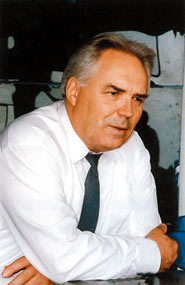
Home >> The IAF Today >> Super Flanker Special >>
VayuSena
Science & Life, April 2002
By: T. Novgorodskaya
Translated into English and notes by Venik (aeronautics.ru)
"I will never forget the first display flight of the Su-27 in Paris, organized by the British Aerospace along with designers and test pilots of the Sukhoi Design Bureau, - recalls John Farlight - a fighter pilot in the Royal Air Force. - Victor Pugachev was turning his Su-27 360-deg in 10 seconds, the average rate of turn - 36 deg/sec. At that time we could only hope that our next-generation fighter could achieve 25 deg/sec. This is the kind of speed that pilot should be able to turn his plane at to have the entire weapons suit ready for an attack. If we would imagine that our new plane encounter an Su-27 in combat, after 10 second all it will be able to do is to lower the gear and land, if it's lucky. Much of what I've seen at the airshow can be used in real aerial combat. To an average observer an airshow is just a superficial action, but if you are one of the aviation industry experts, a fighter's maneuvering will tell you about its flight limits. Naturally, when you see that there are no limits for an Su-27 or that the aircraft can go vertical, stop, slides down and than resumes normal flight and performs this not once, not twice but time after time, you realize that this is not an exception, not a trick, but a standard. Complexity of this particular maneuver is not in initiating the maneuver but in exiting from it. Usually we are not allowed to exceed 20-25-deg. angles of attack: if we go over it, we lose control of the machine... But the Russians perform their maneuvers, while changing the angle of attack in a wide range, while remaining confident in their control of the aircraft with absolutely symmetrical aerodynamics. The same applies to the engines. The Western engines "suffer" from the strict limitations on the angle of attack. When flying our fighters one has to think about the enemy's maneuvers and about one's own limitations from the aerodynamics point of view, about what a pilot should not do. Of course this is not a very comfortable situation for the pilot. For him it's much easier when he can do anything that is necessary to target the enemy and to pursue him. What the Russians have achieved has astonished us to the bottom of our souls."
With its revolutionary design and aerodynamics, the Su-27 has established new standards in fighter aircraft design. The person, who's name is inseparable from the fighter's creation, is the designer-general of the AOOT "OKB Sukhoi" Mikhail Simonov. In 1995 he was awarded the V.G. Shukhov golden medal and in 1998 he was called "the legend of the year" by the Aviation Week & Space Technology magazine. His name can be found in the Hall of Fame of the National Aerospace Museum in Washington, D.C., along with the names of Igor Sikorsky, S.V. Ilyushin, and Verner von Braun. This is the first interview given by Mikhail Simonov to the "Science and Life" magazine, even though he reads our magazine since 1946.

Everybody, who at least once have seen at an airshow what Sukhoi aircraft are capable of, or even saw their performances in television broadcasts, can't help but wonder why such machines are created?
When I was in the ninth grade, I read a book "Some of the Piloting Mistakes". A pilot can never be guaranteed from mistakes. Aviation has always been and will remain to be very demanding toward pilots and designers. Because of technical malfunctions or crew errors not only the aircraft may die but also the crew and the passengers.
Spin is one of the most complex and dangerous phenomenon. In essence it is uncontrollable flight most dreadfully oriented in space: the aircraft spins out of control with its nose pointed toward the ground. Upon impact the "air pocket" explodes and the aircraft is being torn into small pieces. It may seem that all one needs to do to avoid this problem is to teach all the pilots to recognize the limits after which an aircraft enters a stupor. It should be mentioned that there are several similar phenomenon in aviation that begin with aircraft losing control and rolling on the side, but not all of them result in a stupor. However, despite the fact that all fighter pilots are thought the basic methods for exiting from different types of spins, by far not all of them end up victorious in real-life situations (most often this happens because of piloting mistakes and less often because of technical problems with the aircraft). There are aircraft that cannot exit from certain types of spins due to their aerodynamic peculiarities. Such extreme situations are uncommon in civil aviation. However, for combat aircraft maneuverability is a condition for survival. This is the reason why all aircraft designers around the world are working on the issues of maneuverability. It is maneuverability, in conjunction with armaments carried by the aircraft, that guarantees the aircraft's ability to perform the set tasks.
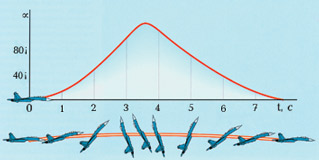
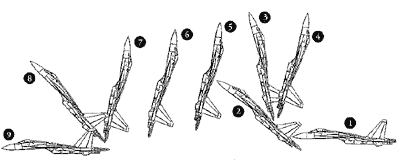
And what tasks are being set?
Maneuverability is the aircraft's capacity to change its position in space. Naturally, the must be a reason for initiating one or another maneuver. Such reasons appear on their own in various combat situations: you must assume such a position in space that the enemy is within the effective range of your weapons, while your aircraft remains outside the enemy's targeting envelop. It is understood that whoever will be able turn and position his aircraft first will be the winner. The classic fighter aircraft of the 1940s-60s of the last century experienced serious problems in combat due to the severe limitations on their ability to maneuver. Normally aerial combat was conducted by large groups of aircraft - say, twenty aircraft - and a huge "swarm" rolled in the air and everyone wanted to survive. Fighter aircraft of classic design differed little from the enemy's aircraft which resulted in prolonged aerial engagements - 5-6 minutes. During that time the engines were pushed to their limits and fuel consumption was high. And even after a victory was achieved, not everyone was able to reach home. Every fifth aircraft was lost after the fight was over simply because it ran out of fuel and had to be dumped. It was good if the pilot was able to eject, but if tried to land - say, on a highway at high speed - the outcome was predetermined.. When entering aerial combat, pilots of some countries knew they would not be able to exit from it. To fly out of the area of combat one would need to expose his "tail", which would be immediately targeted by the enemy. Such a fight was to the end, and when the red fuel light would come on, the pilot would eject from a perfectly functional fighter.
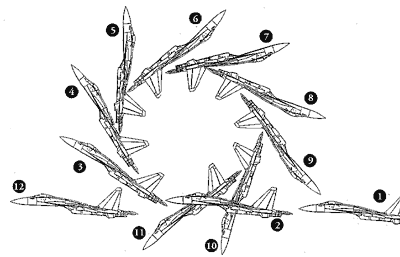
...a sort of a single-use aircraft?
A pilot's life is more precious. But one way or another maneuverability drawbacks are very costly. Thus a breakthrough into the realm of supermaneuverability, when the risk to the pilot and the aircraft becomes minimal, became our top priority.
Is possible to predict that the fighter will be supermaneuverable during the design stage?
You usually know who will be the most likely opponent. At the time the Su-27 was being designed, we were aligned with the Warsaw Pact countries against the NATO. We had to produce and aircraft that would have been significantly superior to such fighters as F-14, F-15, F-16 and F-18.
Within our aviation industry we are represented by the Sukhoi Design Bureau and a large number of outside contactor firms. For example, our radars are made by a number of NII1 and KB2. We do not design engines, we simply produce the requirements for one and it is created by the Lyulka Design Bureau. Such is the scientific and technological union which guarantees the development of a fighter of the highest quality. To make the best plane that can defeat any enemy fighter we need to have the best engine in the world, the best radar, the best missiles in the world and everything else also has to be the best. While working on the Su-27 we created what seemed to be a good aircraft that exceeded capabilities of the F-15, but by how much? By very little. And once again in the situation of close combat we can end up in a complex "carousel", where both fighters will have equal chance of winning.
We realized that in order to obtain a decisive advantage of the opponent our fighter would have to be not just more maneuverable but several times more maneuverable. There is such definition as radial rate of turn toward the target. In combat the advantage rests with the fighter that is able to turn around before its adversary. We have decided that if we are able to make out fighter turn at twice the rate of the opponent, we will call this supermaneuverability.
Supermaneuverability is a fighter's capacity to turn toward its target from any position in space with at least twice the rate of turn that the enemy fighter is capable of.
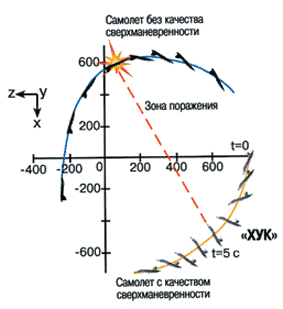
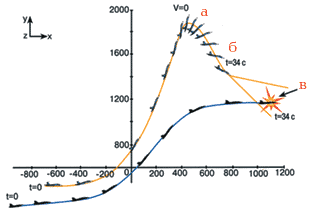
It would seem that in such extreme situations much will be demanded from the engines as well.
First of all the engines must have superior thrust. A modern military aviation engine is a turbojet with an afterburning chamber. (Afterburning is a mode of operation during which additional fuel is injected into the combustion chamber. This achieves a significant increase in the engine's thrust at the cost of additional fuel.) The thrust produced by the two engines of an Su-27 pushes the aircraft with a force equivalent to 25 metric tons (12.5 tons of thrust per engine). Corresponding engines of American fighters at the time the F-15 was created could generate 10.8-11 metric tons of thrust. Of course there are other requirements as well. It would be helpful, for example, to use engines not just to propel the aircraft but also to steer it using special nozzles capable of turning about 15 degrees from their normal position. This is especially important when during combat the plane is pushed beyond the critical angles of attack (AOA). For the Su-27 the critical AOA is 24 degrees. A combat situation may demand the plane to turn 60-90 or even 120 degrees relative to the direction of its flight. When the pilot initiates such a maneuver, the engines must respond instantly by deflecting thrust at the required angle.
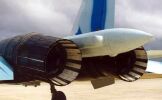
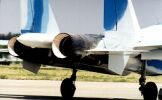
The nozzles of the two turbojet engines AL-31FP used on the multi-functional Su-30MK fighter are capable of deflecting 32 degrees in the horizontal plane and 15 degrees in the vertical plane. This enables the aircraft to perform maneuvers unattainable by other fighters: to rapidly slow down and then turn on a dime similar to a helicopter.
When in 1989 we came to the Paris airshow for the first time with the conclusion of the State Combat Aircraft Testing Institute that flight characteristics of our Su-27 are inferior to those of an American F-15, we were still convinced that our plane was significantly better American aircraft.
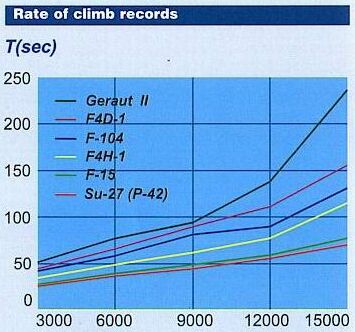
American fighters have set a number of time-to-altitude records. (Time is measured from the time the aircraft starts its take-off run and until it reaches a predetermined altitude - 3000, 6000, 12000 meters and so forth). Thus from a dead stop the aircraft must reach this altitude in the shortest possible time. All world records at that time were held by the F-15.
We have conducted a series of Su-27 flights that beat all F-15 records, thus proving that our plane is superior to the F-15 in the time-to-altitude aspect of performance.
How was this accomplished?
The aircraft must be standing still like a sprinter on the start line. But when the engines are working the wheel brakes alone are not enough to hold the aircraft. To keep the fighter still we tried using a tank. A cable was connected to the hook on the lower part of the fuselage, but we weren't celebrating for long. After just a second of afterburners being engaged we heard a screeching sound and observed how the Su-27 started pulling the tank down the runway. We had to find something else to hold the plane. A nearby runway was under construction and we have noticed a huge "Caterpillar" bulldozer. We attached it to the tank, which was in turn attached to the aircraft. The fighter's start from dead stop was guaranteed.
From the very start, the engines are pushed to their limits. As soon as the cable locking mechanism is released the plane sprints down the runway and starts gaining altitude in a vertical flight. While flying vertically up the plane breaks the sound barrier. No other aircraft, not even a space booster at such low altitude can achieve supersonic speed in vertical climb. Normally this happens only in the upper regions of the atmosphere where air density is very low. However, we could achieve supersonic flight at an altitude of just 2000-3000 meters.4
During that airshow we were able to achieve better results than the Americans.5
In a classic aerial combat two fighters are spinning in a "carousel" until one of them can reach the position from which it can attack its target. However, if can enter close combat and in the first moment turn our aircraft 90 degrees relative to the direction of flight, the target can be locked and missiles can be fired. Thus we can considerably improve close aerial combat and in second, not minutes, guarantee our victory.
They say that originally it was believed that the Su-27 cannot exit from a stupor.
Yes, such was the conclusion of TsAGI after wind tunnel testing of the model: the aircraft cannot exit from a stupor. Something had to be done about this. A system was developed that would not allow the plane to exceed the AOA of 24 degrees.
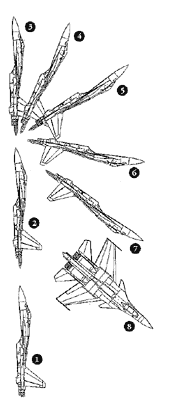
Not a single Su-27 model in TsAGI's wind tunnel was able to exit from the stupor. We challenged this finding by creating a 10-meter half-real-size model of our aircraft, attached it to the Tu-16 bomber and dropped it from 10,000 m. The model had an automatic guidance system that would force it into the spin and, if the model could not exit from it, a landing parachute would be deployed. We discovered that in about half of the situations the larger model would safely exit from a stupor. However, we could not tell the pilot: "Go ahead, everything is fine". And thus we had to agree with TsAGI and establish limits for the aircraft's performance. This was all very strange: we wanted to achieve high angles of attack but could not produced a plane capable of doing this.
The most interesting situation occurred during flight testing. Fighter testing is an enormous work requiring about five thousand test flight, during which the machine is tested for structural strength, its aerodynamic properties, it ability to deliver and deploy weapons and other aspects of performance. Even before the "Cobra" maneuver, Victor Pugachev was performing high AOA maneuvers. I was very worried about this because I knew about the problems experienced by the American F-16 fighter during high AOA testing, when the aircraft was able to achieve a 60-deg. angle of attack but was only able to exit from this maneuver by using a special anti-spin parachute. We chose a different approach to testing our plane, but were still very apprehensive when Pugachev entered a high AOA. However, he was able to exit from it and everything ended well.
Further testing proved that the Su-27 would not fall into a spin when performing high AOA maneuvers. The results have shown that it is possible to take the plane to high angles of attack and then return it safely to the normal mode of operation. This finding was what opened the future for supermaneuverability. But 20 years ago we could not realize this, we were conducting just the first test flights.
During one of such flight conducted by test-pilot V. Kotlov experienced a depressurization of the air pressure sensor 6, which gave him an incorrect air speed reading. The pilot tried to compensate what he though was very high speed by increasing the climb angle and finally the aircraft came to rest in a vertical position at an altitude of 8000 meters and started sliding down with its tail first. The pilot's hopes that the plane will eventually return to normal flight did not materialize, instead the aircraft seemed to be "suspended" between the sky and the ground. This was unexpected and baffling: the air speed was near zero and the altitude was 8000 meters. The pilot panicked, he switched off the afterburners and immediately engaged them again. The plane started falling on its tail and the pilot experienced weightlessness - in the future this maneuver was to be called the "Kolokol", or the "Bell". 7
And all of that happened in just a few seconds?
About 20 seconds. In the air it seems like much longer. Once the aircraft has reached the 60-deg. AOA (and we only had the permission for 24 degrees) the aircraft fell into a spin and started spinning with its nose pointed toward the ground. The pilot then realized what has happened and reported to the ground controller: "Stupor!" Since it was believed that an Su-27 cannot exit from a stupor, the ground controller's only order for the pilot was as if struck in stone: "Eject at an altitude of no lower than 4,000 meters."
Ejecting is hardly a pilot's favorite thing to do, thus to avoid serious injuries the pilots has released the controls and started preparing for the ejection. However, at the last moment he noticed that the aircraft had exited from the spin and now beginning to exit from the dive as well. The Su-27, when left on its own, was able to return to the normal flight. After verifying that the aircraft was still controllable, Kotlov made a safe landing.
Perhaps this was just a coincidence?
This was our conclusion at first as well: for the 1000 flights this was the only such situation. On the big count this did not matter. However, a shirt time later an even more incredible situation occurred in the Far East. An Su-27 pilot was performing an automatic intercept exercise. The plane exceeded the critical angle of attack and entered a stupor. Following the order from the ground controller the pilot ejected, after which the Su-27 exited from the spin and the autopilot resumed its course until the plane ran out of fuel. Soon after a third such incident occurred in Lipetsk8. This forced us to establish a special research plan to investigate this phenomenon. As it turned out during the course of the investigation, the Su-27 exhibited certain instability when entering the spin and exiting from it. It was established that even the most effective aerodynamic methods for exiting from a spin did not always result in the desired outcome. At the same time in a number of situations the plane would exit from a spin on its own when the position of its control surfaces was neutral. This was later explained by the peculiarities of the Su-27's air vortex aerodynamics at various angles of glide and attack.
A considerable role in our "victory" over the spin was played by the accomplished test-pilot, cosmonaut Igor Volk. He conducted a series of test flights and determined that the Su-27 can exit from all variations of a stupor.
So why did model tests resulted in an opposite conclusion?
It turned out that it wasn't the aircraft's layout but the size of the model that mattered most in this situation (the Reynolds number9 in fluid dynamics connects the speed of flight, the size of the aircraft and the viscosity of air and this number is considerably greater for full-size aircraft than for their small-scale models.)
How is that that supermaneuverability leads to the reduction of the aircraft's visibility on the radar screen?
Supermaneuverability should be looked at as a system of maneuvers for close aerial combat. Once the pilot receives a signal that his plane is being tracked by an enemy radar, the first thing he needs to do is to go vertical. While gaining altitude and losing speed the aircraft starts to disappear from the screens of radars that use the Doppler effect. 10 However, the opponent is no fool either and will counter by pitching his aircraft upward as well. By that time our plane is going vertical and its speed approaches zero. But all Doppler radars can recognize only a moving target. If the aircraft speed is zero or simply low enough to prevent the enemy radar from calculating the Doppler component, for the enemy our aircraft will disappear. He may still be able to track us visually, but he will not be able to launch a radar-guided missile (either active or semi-active), simply because the missile's seeker would not pick-up the target.
Are there any other methods to make a plane invisible to a radar?
The so-called "stealth" aircraft are just beginning to emerge. The greatest impact of this new technology is expected for the fifth-generation fighters.11 The first combat aircraft created using this stealth technology was the fighter-bomber F-117A. Although, the aircraft never became a fighter.12 The aircraft had very low radar visibility but poor flying characteristics - a sort of a edgy flying steam iron (comprised of many flat panels the aircraft would reflect the radar signal away from the receiver.)13
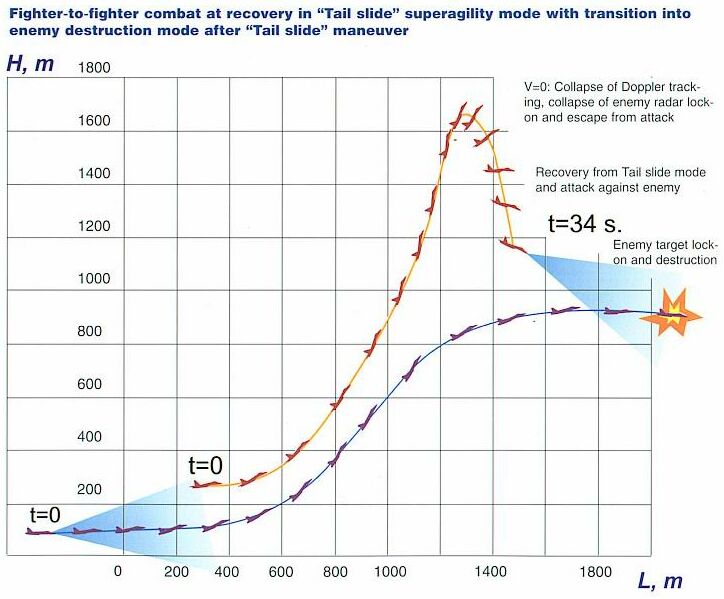
I read somewhere that, during the creation of the new fighter, you realized a need for a drastic upgrade of the onboard electronic equipment. How reliable is this equipment on supermaneuverable aircraft?
Generally people discount "Russian" electronics as inconsequential. I have a different opinion. We ask from our radar designers what we want and they deliver. If the radar aboard the F-15 weighs 244 kg, our analog weighs several times more. But this does not worry us. Our goal is to be able to detect targets at greater distances. The same can be said about the optical detection and targeting systems.
When American SR-71 strategic reconnaissance planes were visiting us from the direction of Norway, Su-27s and Su-30s were positioned along the entire coast up to Novaya Zemlya to guard our northern airspace. When the SR-71 appeared once again our fighters were already in the air. We decided to play a trick on the Americans and did not engage onboard radars, instead relying on optical detection systems, which can "see" targets at considerable distances in infra-red spectrum. When the SR-71 and our fighters were closing in on opposite courses, we were able to track the SR-71 at a great distance. The "American" did not violate our airspace, but we still kept it in the crosshairs.14

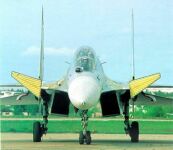
So, you cannot say that our electronic equipment is worse. It is exactly what we ask for based on our knowledge of the enemy aircraft. And as to making an aircraft that can lift our electronics - that's not a problem.
Is it true that to improve the aerodynamic performance the new-generation fighters use a different type of a wing?
In order to reduce the wing's wave resistance during supersonic flight the wing has be swept relative to the velocity vector. If the wing is positioned in such a way that turbulence causes it to twist and bend downwards, the wing's lifting capacity drops but its structural stability remains high. In the case of a forward-swept wing gusts of air bend it upward, which increases the wing's lifting capability and, as it increases, so does the bending and twisting of the wing. Despite a danger of structural collapse of the wing, aircraft with forward-swept wings show excellent aerodynamic performance.
Americans worked on an experimental forward-swept-wing aircraft called the X-29, but for some reason did not find it's design promising.15 We, on the other hand, believe that this problem can be solved by using composite materials in the wing's construction. A metal wing cannot withstand the divergence - high forces created due to the wing being twisted. We had situations when metal wings of forward-swept-wing aircraft model would break during wind tunnel testing. Today we can create a special composite structure based on carbon fibers, epoxy and organic materials with a high resistance to twisting and pulling forces - some of these materials are used in armored vests.
What are your hopes for the fifth-generation fighter in terms of supermaneuverability?
I have very high expectations. If our "competitors" are building a fifth-generation fighter, then we need one as well. One can say it's a rule of equilibrium. Not long ago we attended one foreign airshow and the air force commander of one of the countries told us: "We need your plane. We have different fighters, but in addition to those we want to have a Russian fighter with such characteristics so than the enemy would be afraid to attack us." This is the role of the new fighter - to provide political equilibrium in the world.
NOTES:
(1) Abbreviation for Nauchno-Issledovatelski Institut, or Scientific Research Institute.
(2) Abbreviation for Konstruktorskoe Buro, or Design Bureau.
(3) Time-to-altitude performance is one of the most important flight performance characteristics of a fighter aircraft, determining how fast an aircraft can respond to the detected violation of the airspace and to intercept usually high-flying targets, such as reconnaissance aircraft and strategic bombers.
(4) Keep in mind that Simonov talks about achieving supersonic speed in vertical climb to this altitude, not in horizontal flight at this altitude, which can be done by a number of other fighter aircraft.
(5) In June of 1989 the Reuters reported from the Le Bourget airshow: "Looks like the competition between Soviet and American fighters in the skies of Le Bourget has been won by the Soviet Union. The Russians succeeded thanks to their snake-like aircraft whose promising design and ease of control shocked the experts."
(6) The Pitot tube - a long tubular protrusion in the nose cone of a fighter allows to determine the aircraft's speed by measuring the pressure of air inside the receptor. A depressurized air pressure sensor would result in the higher air speed reading.
(7) This is not the same as the "Bell" maneuver in the Western terminology. The maneuver described by Simonov is often refereed to as "Tailslide" maneuver in the West.
(8) Russian Air Force Academy is located in Lipetsk.
(9) "Fluid flow can be either laminar or turbulent. The factor that determines which type of flow is present is the ratio of inertia forces to viscous forces within the fluid, expressed by the nondimensional Reynolds Number: R = (rho*V*D/mu), where V and D are a fluid characteristic velocity and distance." (Fluid Mechanics, 2nd ed., by Landau, L.D.)
(10) Originally discovered by the Austrian mathematician and physicist, Christian Doppler (1803-53), this change in pitch results from a shift in the frequency of mechanical compression (i.e. sound waves) and electromagnetic waves.
(11) "Fifth-generation" is a relative term and usually describes the F-22, JSF and the Russian counterparts in development (MFI and LFS).
(12) Actually, the F-117A, despite its "F" (for "fighter") designation, was never intended to be anything other than a light bomber, even though the aircraft was tested with AIM-9 Sidewinder air-to-air missiles (without much success). The aircraft was presented as a multi-functional fighter-bomber to the government and the public to justify its high cost and also to place the aircraft under the USAF command rather than under the command of now defunct SAC (Strategic Air Command was eliminated as a separate organization in July of 1992).
(13) In 1966 a well-known Soviet mathematician, Pyotr Ufimtsev, published a paper in which he described mathematical methods to predict RCS (actually, the field of dispersion) of two-dimensional objects (that's why the F-117 is comprised of flat two-dimensional panels: even though Ufimtsev's method allowed to calculate any type of surfaces, not just flat, his calculations provided in the book were limited to such and it took Lockheed and Northrop-Grumman mathematicians some time to develop methods for complex curved surfaces). Ufimtsev's work was directly used by Lockheed's mathematician, Denys Overholser, to develop computer software known as "Echo 1", which could calculate the RCS of an aircraft constructed of flat panels. This program was used to find the optimum geometry to minimize an aircraft's RCS. The resulting structure became known as "Hopeless Diamond", which lies in the basis of F-117A's external construction. Simply put, the flat, angled external panels of F-117A are designed to reflect radar waves in all directions but the direction of the radar's receiving antenna. This means that to effectively track F-117A one would have to use multiple radars (or, at least, multiple receivers.) Needless to say that the geometrical requirements for minimizing the RCS established by "Echo 1" program had little place for considerations of aerodynamics. The resulting aircraft had the aerodynamics of a flying coffin (some of the modern anti-stealth radars take advantage of F-117A's poor aerodynamics and target the aircraft by detecting the considerable trail of turbulent air left by the aircraft's boxy airframe.)
(14) SR-71 was originally intercepted by six MiG-31s, and, on one of its later flights, by Sukhois. During the first intercept by the MiGs, the SR-71 was actually in violation of the Soviet airspace, but was able to leave it before the MiGs caught up with it. The "Black Bird" was retired by the USAF shortly after these intercepts.
(15) During a simulated combat exercise the X-29 was flying against an F-18 and proved its ability to turn its weapons against the F-18 from any position in space considerably faster than the F-18 was able to target the X-29. The F-18 lost all simulated engagements to the X-29, even when the latter was placed at a considerable disadvantage in terms of speed and position. There are a few likely explanations for the X-29's unrealized potential: first, the forward-swept wing is not compatible with the conventional stealth geometry concepts; second, X-29's developers had structural problems with the wing and could not come up with the composite material similar to that used Sukhoi S-37 (and the Sukhoi is considerably larger and heavier than the X-29 and experiences greater forces acting on its wings); finally, the USAF officials did not look favorably on the unorthodox X-29, just as their Russian counterparts viewed the unusual S-37 with suspicion.
| The IAF Today | : | Su-30MKI Info |
| The IAF Today | : | Ex Cope India article from "Inside the Air Force" |
| The IAF Today | : | Interview with Victor Chepkin |
| The IAF Today | : | Interview with Alexey Fedorov |
| The IAF Today | : | Interview with Victor Pugachev |
| The IAF Today | : | Su-30MKI Vs F-16C and F/A-18E/F |
| The IAF Today | : | How Su-30MK beats the F-15 in USAF Simulations |
| The IAF Today | : | Su-30MK Vs Mirage-2000-5 |
Created On: 02.Jul.2002

Comments or Questions? Contact Us
[Home] [The IAF Today] [Other Ops & Incidents] [Kargil 1999] [1980s] [1971] [1965] |
| Top |